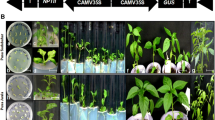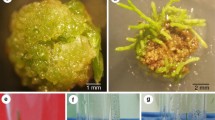Summary
A rapid regeneration system was used for studies ofAgrobacterium-mediated transformation inPisum sativum L. Cotyledonary node explants were inoculated withAgrobacterium tumefaciens strains containing binary vectors carrying genes for nopaline synthase (NOS),β-glucuronidase (GUS), and neomycin phosphotransferase (NPTII) and placed on selection medium containing either 75 or 150 mg/liter kanamycin. A GUS encoding gene (uidA) containing an intron was used to monitor gene expression from 6 to 21 days postinoculation. GUS activity could be observed 6 days after inoculation in the area of the explant in which regeneration-occurred. Regenerating tissue containing transformed cells was observed in explants on selection medium 21 days postinoculation. Using this system, a single transgenic plant was obtained. Progeny of this plant, which contained two T-DNA inserts, demonstrated segregation for the inserts and for expression of the NOS gene in the selfed R1 progeny. NPTII activity was observed in the R2 generation, indicating inheritance and expression of the foreign DNA over at least two generations. Attempts to repeat this procedure were unsuccessful.
Similar content being viewed by others
References
An, G.; Costa, M. A.; Mitra, A., et al. Organ-specific and developmental regulation of the nopaline synthase promoter in transgenic tobacco plants. Plant Physiol. 88:547–552; 1988.
An, G.; Costa, M. A.; Ha, S.-B. Nopaline synthase promoter is wound inducible and auxin inducible. Plant Cell 2:225–233; 1990.
Christou, P.; McCabe, D. E.; Martinell, B. J., et al. Soybean genetic engineering—commercial production of transgenic plants. Trends Biotech. 8:145–151; 1990.
Deblaere, R.; Bytebier, B.; De Greve, H., et al. Efficient octopine Ti plasmid-derived vectors forAgrobacterium-mediated gene transfer to plants. Nucleic Acids Res. 13:4777–4778; 1985.
Dellaporta, S. L.; Wood, J.; Hicks, J. B. Maize DNA miniprep. In: Molecular biology of plants. A laboratory manual. New York: Cold Spring Harbor Laboratory; 1985:36–37.
Draper, J.; Scott, R.; Armitage, P., et al. Plant genetic transformation and gene expression. A laboratory manual. London: Blackwell Scientific Publications; 1988.
Eapen, S.; Köhler, F.; Gerdemann, M., et al. Cultivar dependence of transformation rates in moth bean after co-cultivation of protoplasts withAgrobacterium tumefaciens. Theor. Appl. Genet. 75:207–210; 1987.
Gamborg, O. L.; Miller, R. A.; Ojima, K. Nutrient requirements of suspension cultures of soybean root cells. Exp. Cell Res. 50:151–158; 1968.
Gasser, C. S.; Fraley, R. T. Genetically engineering plants for crop improvement. Science 244:1293–1299; 1989.
Hinchee, M. A. W.; Conner-Ward, D. V.; Newell, C. A., et al. Production of transgenic soybean plants usingAgrobacterium-mediated DNA transfer. Bio/Technology 6:915–922; 1988.
Hobbs, S. L. A.; Jackson, J. A.; Mahon, J. D. Specificity of strain and genotype in the susceptibility of pea toAgrobacterium tumefaciens. Plant Cell Rep. 8:274–277; 1989.
Hobbs, S. L. A.; Kpodar, P.; DeLong, C. M. O. The effect of T-DNA copy number, position and methylation on reporter gene expression in tobacco transformants. Plant Mol. Biol. 15:851–864; 1990.
Hood, E. E.; Helmer, G. L.; Fraley, R. T., et al. The hypervirulence ofAgrobacterium tumefaciens A281 is encoded in a region of pTiBo542 outside of T-DNA. J. Bacteriol. 168:1291–1301; 1986.
Jackson, J. A.; Hobbs, S. L. A. Rapid multiple shoot production from cotyledonary node explants of pea (Pisum sativum L.). In Vitro Cell. Dev. Biol. 26:835–838; 1990.
Lulsdorf, M. M.; Rempel, H.; Jackson, J. A., et al. Optimizing the production of transformed pea (Pisum sativumL.) callus using disarmedAgrobacterium tumefaciens strains. Plant Cell Rep. 9:479–483; 1991.
Murashige, T.; Skoog, F. A revised medium for the rapid growth and bioassays with tobacco tissue cultures. Physiol. Plant. 15:473–497; 1962.
Potrykus, I. Gene transfer to plants: assessment and perspectives. Physiol. Plant. 79:125–134; 1990.
Puonti-Kaerlas, J.; Stabel, P.; Eriksson, T. Transformation of pea (Pisum sativum L.) byAgrobacterium tumefaciens. Plant Cell Rep. 8:321–324; 1989.
Puonti-Kaerlas, J.; Eriksson, T.; Engström, P. Production of transgenic pea (Pisum sativum L.) plants byAgrobacterium tumefaciens-mediated gene transfer. Theor. Appl. Genet. 80:246–252; 1990.
Puonti-Kaerlas, J.; Eriksson, T.; Engström, P. Inheritance of a bacterial hygromycin phosphotransferase gene in the progeny of primary transgenic pea plants. Theor. Appl. Genet. 84:443–450; 1992.
Radke, S. E.; Andrews, B. M.; Moloney, M. M., et al. Transformation ofBrassica napus L. usingAgrobacterium tumefaciens: developmentally regulated expression of a reintroduced napin gene. Theor. Appl. Genet. 75:685–694; 1988.
Rogers, S. G.; Klee, H. J.; Horsch, R. B., et al. Improved vectors for plant transformation: expression cassette vectors and new selectable markers. Methods Enzymol. 153:253–277; 1987.
Sambrook, J.; Fritsch, E. F.; Maniatis, T. Molecular cloning: a laboratory manual. New York: Cold Spring Harbor Laboratory; 1989.
Vancanneyt, G.; Schmidt, R.; O’Connor-Sanchez, A., et al. Construction of an intron-containing marker gene: splicing of the intron in transgenic plants and its use in monitoring early events inAgrobacterium-mediated plant transformation. Mol. & Gen. Genet. 220:245–250; 1990.
Author information
Authors and Affiliations
Rights and permissions
About this article
Cite this article
Jordan, M.C., Hobbs, S.L.A. Evaluation of a cotyledonary node regeneration system forAgrobacterium-mediated transformation of pea (Pisum sativum L.). In Vitro Cell Dev Biol - Plant 29, 77–82 (1993). https://doi.org/10.1007/BF02632256
Received:
Accepted:
Issue Date:
DOI: https://doi.org/10.1007/BF02632256




